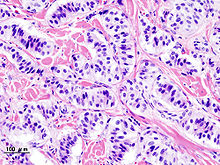Neuroendocrine tumors of the pancreas
Neuroendocrine tumors of the pancreas include insulinoma, gastrinoma, glucagonoma, somatostatinoma, VIPoma. Collectively, tumors derived from the cells of the Islets of Langerhans are referred to as nesidiomas.
Insulinoma[edit | edit source]
Insulinoma is, in most cases, benign tumor (adenoma) derived from insulin producing β-cells of the Islets of Langerhans. The most common localization is the head and body of the pancreas. The malignant variant (nesidioblastoma) occurs in only about 5-10% of cases. Women are more often affected, it occurs between the ages of 20 and 75. It is the most common of all neuroendocrine tumors of the pancreas.
Clinical picture[edit | edit source]
The classic manifestation is morning hypoglycemia due to excessive insulin production, manifested mainly on an empty stomach. The most manifested are neuroglycopenic symptoms - headaches, diplopia and impaired vision, behavioral changes, decreased concentration, speech and consciousness disorders. Sympathoadrenal axis activation is less common (sweating, palpitations, tachycardia).
Diagnostics[edit | edit source]
The most important criterion is the patient's clinical condition (see above). A typical Whipple triad is described for insulinomas:
- laboratory confirmed hypoglycemia (≤ 2.5 mmol),
- presence of symptoms of hypoglycaemia,
- adjustment of the condition after serving sweet food (glucose).
Gastrinoma[edit | edit source]
Glucagonoma[edit | edit source]
Tumor arising from A-cells of the pancreas. It is relatively rare but often malignant and metastasizing. Clinical picture:
- necrolytic migrating erythema,
- increased catabolism,
- elevated blood glucose,
- dyslipidemia,
- cholelithiasis, steatorrhea.
Somatostatinoma[edit | edit source]
Very rare malignant with early liver metastasis. Clinical picture:
- dyspepsia,
- diarrhea,
- weight loss,
- abdominal pain, cholelithiasis, steatorrhea,
- anemia.
VIPoma[edit | edit source]
Rare tumor producing vasoactive intestinal peptide. Clinical picture:
- watery diarrhea, hypokalaemia, acidosis.



